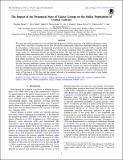Files in this item
The impact of the dynamical state of galaxy groups on the stellar populations of central galaxies
Item metadata
| dc.contributor.author | Raouf, Mojtaba | |
| dc.contributor.author | Smith, Rory | |
| dc.contributor.author | Khosroshahi, Habib G. | |
| dc.contributor.author | Dariush, Ali A. | |
| dc.contributor.author | Driver, Simon | |
| dc.contributor.author | Ko, Jongwan | |
| dc.contributor.author | Hwang, Ho Seong | |
| dc.date.accessioned | 2020-01-06T17:30:03Z | |
| dc.date.available | 2020-01-06T17:30:03Z | |
| dc.date.issued | 2019-12-26 | |
| dc.identifier | 265382090 | |
| dc.identifier | b97233b2-1e0c-4088-9950-4051331f816d | |
| dc.identifier | 85077319627 | |
| dc.identifier.citation | Raouf , M , Smith , R , Khosroshahi , H G , Dariush , A A , Driver , S , Ko , J & Hwang , H S 2019 , ' The impact of the dynamical state of galaxy groups on the stellar populations of central galaxies ' , Astrophysical Journal , vol. 887 , no. 2 , 264 . https://doi.org/10.3847/1538-4357/ab5581 | en |
| dc.identifier.issn | 0004-637X | |
| dc.identifier.other | ArXiv: http://arxiv.org/abs/1911.02976v1 | |
| dc.identifier.uri | https://hdl.handle.net/10023/19232 | |
| dc.description.abstract | We study the stellar populations of the brightest group galaxies (BGGs) in groups with different dynamical states, using Galaxy And Mass Assembly survey data. We use two independent, luminosity-dependent indicators to probe the relaxedness of their groups: the magnitude gap between the two most luminous galaxies (ΔM 12), and the offset between BGGs and the luminosity center (D offset) of the group. Combined, these two indicators were previously found useful for identifying relaxed and unrelaxed groups. We find that the BGGs of unrelaxed groups have significantly bluer near-ultraviolet-r colors than in relaxed groups. This is also true at the fixed sersic index. We find the bluer colors cannot be explained away by differing dust fraction, suggesting there are real differences in their stellar populations. Star formation rates derived from spectral energy distribution (SED) fitting tend to be higher in unrelaxed systems. This is in part because of a greater fraction of BGGs with non-elliptical morphology, but also because unrelaxed systems have larger numbers of mergers, some of which may bring fuel for star formation. The SED-fitted stellar metallicities of BGGs in unrelaxed systems also tend to be higher by around 0.05 dex, perhaps because their building blocks were more massive. We find that the ΔM 12 parameter is the most important parameter behind the observed differences in the relaxed/unrelaxed groups, in contrast with the previous study of Trevisan et al. We also find that groups selected to be unrelaxed using our criteria tend to have higher velocity offsets between the BGG and their group. | |
| dc.format.extent | 11 | |
| dc.format.extent | 10056225 | |
| dc.language.iso | eng | |
| dc.relation.ispartof | Astrophysical Journal | en |
| dc.subject | Galaxy structure | en |
| dc.subject | Galaxy groups | en |
| dc.subject | Galaxy evolution | en |
| dc.subject | Galaxy colors | en |
| dc.subject | Stellar populations | en |
| dc.subject | Galaxy classification systems | en |
| dc.subject | QB Astronomy | en |
| dc.subject | QC Physics | en |
| dc.subject | 3rd-DAS | en |
| dc.subject.lcc | QB | en |
| dc.subject.lcc | QC | en |
| dc.title | The impact of the dynamical state of galaxy groups on the stellar populations of central galaxies | en |
| dc.type | Journal article | en |
| dc.contributor.institution | University of St Andrews. School of Physics and Astronomy | en |
| dc.identifier.doi | 10.3847/1538-4357/ab5581 | |
| dc.description.status | Peer reviewed | en |
This item appears in the following Collection(s)
Items in the St Andrews Research Repository are protected by copyright, with all rights reserved, unless otherwise indicated.

